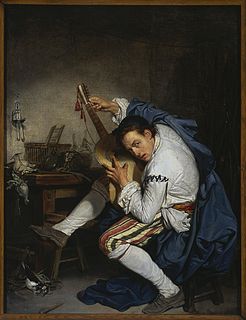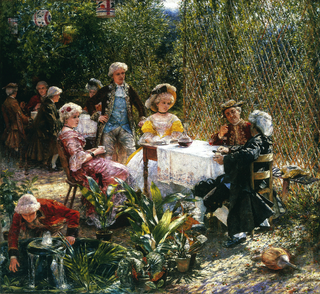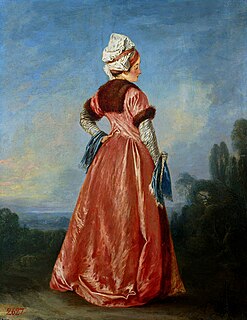 W
WAdam and Eve is a pair of paintings by German Renaissance master Lucas Cranach the Elder, dating from 1528, housed in the Uffizi, Florence, Italy. There are other paintings by the same artist with the same title, depicting the subjects either together in a double portrait or separately in a pair of portraits, for instance at the Kunsthistorisches Museum in Vienna, the Courtauld Gallery in London, the Museum der bildenden Künste in Leipzig, and the Art Institute of Chicago.
 W
WAt the Seashore is an 1886 oil painting by Polish painter Anna Bilińska. It is displayed at the National Museum in Warsaw, Poland.
 W
WBishop Petros with Saint Peter the Apostle is a Nubian Christian wall painting from the last quarter of the 10th century. Made with tempera on silt plaster using an al secco fresco technique, it depicts Petros, the bishop of Faras between 974 and 997. The anonymous work was discovered in the ruins of Faras Cathedral, an important religious centre of Nubia, in modern Sudan. Rescued from flooding when Lake Nasser was created, since 1964 it is part of the Faras Gallery of the National Museum in Warsaw.
 W
WColonel Königsfels Teaching Prince Poniatowski to Ride is a 1773 oil on canvas painting by Bernardo Bellotto, now in the National Museum, Warsaw.
 W
WMountainous Landscape with Figures and a Donkey is an oil on panel painting by Flemish painter Joos de Momper. The painting is currently housed at the National Museum in Warsaw.
 W
WEcce Homo is a subject of a series of oil on panel paintings by Andrea Solari, dating to between 1505 and 1510. Its hands show the influence of Solari's master Leonardo da Vinci and particularly his Lady with an Ermine.
 W
WThe Battle of Grunwald is a painting by Jan Matejko depicting the Battle of Grunwald and the victory of the allied Crown of the Kingdom of Poland and Grand Duchy of Lithuania over the Teutonic Order in 1410. The canvas dates to 1878 and is one of the most heroic representations of the history of Poland and Lithuania. It is displayed in the National Museum in Warsaw.
 W
WThe Guitar Player or The Guitarist is a c. 1757 oil on canvas painting by Jean-Baptiste Greuze, produced during the artist's stay in room. It is now on display in Room VII at the National Museum, Warsaw. It shows a young man tuning a guitar, with hunting accessories in the left background symbolising his being a bird-hunter.
 W
WIn the Arbour is an oil painting created by Polish Realist painter Aleksander Gierymski in 1882. It is displayed at the National Museum in Warsaw, Poland.
 W
WIndian Summer is an 1875 oil painting by Polish Realist painter Józef Chełmoński. It is considered one of the artist's most acclaimed works and is currently displayed at the National Museum in Warsaw, Poland.
 W
WJewess with Oranges is an 1880-1881 oil painting on canvas by the Polish artist Aleksander Gierymski. During World War II, the painting was stolen by German forces and recovered in 2011.
 W
WThe Master of the Grudziądz Altarpiece was a Bohemian artist, active at the end of the 14th and the beginning of the 15th century. His name is derived from an altarpiece which hung in the castle of the Teutonic Knights in Grudziądz, and may now be seen in National Museum in Warsaw. Closed, the altarpiece depicts the Noli me tangere and the resurrection of the dead on two registers to the left; on the right, Christ in Majesty and the Virgin and John the Apostle. The wings show eight scenes from the Passion, while inside are scenes from the Life of the Virgin. At the center is an image of the Death and Coronation of the Virgin.
 W
WMountain Landscape with Campers and a Broken Tree is an oil on panel painting by Flemish painter Joos de Momper. The painting is currently housed at the National Museum in Warsaw.
 W
WA Negress is an 1884 oil painting by the Polish artist Anna Bilińska. The painting was stolen from the National Museum in Warsaw during World War II and remained missing until it appeared at auction in 2011 and was returned to the museum in 2012.
 W
WPeasant Coffin is an oil painting by Aleksander Gierymski.
 W
WPolish Hamlet. Portrait of Alexander Wielopolski is an oil painting by Jacek Malczewski from 1903, presenting the allegorical grandson Alexander Wielopolski and two different visions of the fate of the Polish nation.
 W
WPolish Woman is an oil on panel painting in the National Museum, Warsaw, historically attributed to the French Rococo artist Jean-Antoine Watteau. The painting correlates to a presumably lost drawing by Watteau that is now known via François Boucher's etching published in 1726 as part of the Recueil Jullienne. Given that the painting is not signed, its attribution and dating remains uncertain; various authors either accept or reject the painting as a Watteau, dating it from the early 1710s to the early 1730s.
 W
WThe Portrait of Adam Mickiewicz on the Ayu-Dag Cliff is an oil portrait of Adam Mickiewicz by Walenty Wańkowicz created from 1827 to 1828. Since 1925 it has been in the collection of the National Museum, Warsaw.
 W
WPortrait of Barbara Lubomirska is a 17th-century funerary portrait of the Polish noblewoman Barbara Lubomirska. She died between 1667 and 1676 and the portrait is shaped like a cross-section of her coffin. It was painted in oil on a sheet of metal by an anonymous master-painter active in Masovia in mid-second half of the 17th century. The painting is on display at the National Museum in Warsaw on loan from the Portrait Gallery of the Palace Museum in Wilanów. It is a prominent example of the funerary art tradition popular among the nobles (szlachta) of the Polish–Lithuanian Commonwealth.
 W
WPortrait of Martin Luther is a 1564 oil on canvas painting by Lucas Cranach the Younger and studio, in St. Elizabeth's Church, Wrocław before World War Two and now in the National Museum, Warsaw. It is based on Lucas Cranach the Elder's three-quarter length 1539 portrait of Martin Luther.
 W
WThe Prisoners is an 1883 oil painting by Polish painter Jacek Malczewski. It depicts a group of Polish political prisoners exiled to Siberia for their participation in the national January Uprising of 1863–1864 against Tsarist Russia. It is now displayed at the National Museum in Warsaw.
 W
WThe Queuing continues is an oil painting by Andrzej Wroblewski from 1956.
 W
WSaint Anne is a Makurian wall painting estimated to have been painted between the 8th and 9th centuries, painted al secco with tempera on plaster. The anonymous work was found at the Faras Cathedral within old Nubia in present-day Sudan.
 W
WThe Sermon of Piotr Skarga or Skarga's Sermon is a large oil painting by Jan Matejko, finished in 1864, now in the National Museum, Warsaw in Poland. It depicts a sermon on political matters by the Jesuit priest Piotr Skarga, a chief figure of the Counter Reformation in Poland, where he rebukes the Polish elite for neglecting the national interest.
 W
WStańczyk is a painting by Jan Matejko finished in 1862. This painting was acquired by the Warsaw National Museum in 1924. During World War II it was looted by the Nazis and subsequently by the Soviet Union, but was returned to Poland around 1956.
 W
WUnion of Lublin is an oil painting by the Polish artist Jan Matejko, finished in 1869, depicting the Union of Lublin. It is owned by the National Museum, Warsaw. and displayed at National Museum of Lublin.
 W
WZawieszenie dzwonu Zygmunta is a painting by Jan Matejko finished in 1874. It depicts the installation of the Sigismund Bell in the Wawel Cathedral in Kraków in 1521. The bell was installed in the Sigismund Tower and rung for the first time on 13 July 1521. The bell is considered to be one of the national symbols of Poland. This painting is one of a number of historical paintings by Matejko. It shows a crowd of people, with a number of identifiable figures of historical importance. It conveys the Golden Era of the Polish Renaissance, and the power of the Kingdom of Poland.